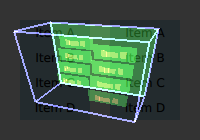Recently, as I was watching some QML presentation I realized that some very basic pieces of performance advice I just glossed over in the book could (and should) be explained in a much more detailed manner to build a general understanding of this technology's caveats.
In Chapter 8.4, where the book discusses QML's performance, I simply wrote that:
"If an item shouldn't be visible, set its visible attribute to false, this will spare the GPU some work. In the same vein, use opaque primitives and images where possible to spare GPU from alpha blending work."As I re-read this section on some occasion I somehow had to notice that what seemed pretty clear in writing, isn't that clear when read a year later! I started to think why this passage is not that lucid as it should be, and I noticed, that my intended formatting was gone! Now we have in the book:
"... set its visible attribute to false"
instead of
"... set its visible attribute to false"
as I wrote it initially!!! The formatting went somehow missing and I didn't notice it while proofreading. For me this change rendered the sentence pretty unintelligible :-/.
But anyway, I could have explained it in a little more detailed manner* - so let's try to make a better job and explain why the visible attribute is so important!
To state it bluntly - QML won't do any optimizations to prevent drawing items the user cannot see, like items which are out of bounds or are completely obscured or clipped** by other items! It just draws every single item with visible set to true, totally unconcerned with its real visibility! So we have to optimize manually and:
"... set its visible attribute to false"
But how on earth should we know which items are invisible in which situation? Easy, just set this environment variable: QSG_VISUALIZE=overdraw and Qt will show the overdrawn items using a different color and making them visible as can be seen in this pic from Qt documentaion:
That's pretty cool!
This was my state of knowledge until recently (learned about that in this KDAB presentation) but than I read this line in Qt Quick 2D Renderer's documentation:
Qt Quick 2D Renderer will paint all items that are not hidden explicitly with either the visibility property or with an opacity of 0. Without OpenGL there is no depth buffer to check for items completely obscured by opaque items, so everything will be painted - even if it is unnecessary.Qt Quick 2D Renderer is a raster-graphic replacement for the standard OpenGL-based QML renderer. Does that (by tertium non datur) mean that with OpenGL we do use the depth buffer after all? This could be an unfortunate formulation, so we'd like to stay on the conservative side but maybe a little more investigation would be appropriate in this case. Have you heard anything about it?
* This might be due to the very tight deadlines :-(
** as Qt documentation says:
"If clipping is enabled, an item will clip its own painting, as well as the painting of its children, to its bounding rectangle."





No comments:
Post a Comment